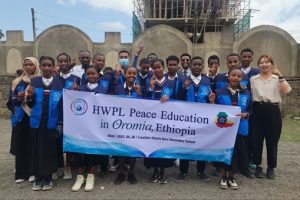
BY ABEBE WOLDEGIORGIS
Global warming and climate change have been the pressing issues which affect various sectors all over the world. Mitigating the problem depends on the country’s economic, technological, research and study capacity, trained human resources and infrastructural development.
The advanced countries which highly contributed to emission and that poses threat to the climate are in a better position to withstand the crises. Contrary to this poor countries which are highly victimized by the global warming are shouldering the brunt of the problem.
Unless they obtained financial and technological support from the rich countries, low income countries would face further trouble. The latter’s economy highly depend on rain-fed agriculture, and are egregiously faced with insurmountable problems. Problems including drought and crop failure are posing food shortages.
According to Economists, although agriculture is the main zone of the nation’s economy, around 85 percent of the population’s livelihood is depending on the sector. It has been the mainstay of the financial system of the economy and will stay so in the future. It affords approximately half of the Growth Domestic Products and 85 percent of foreign exchange earnings.
It also serves as supplier of food demand at least in the subsistence level. Currently due to global warming particularly in the developing countries, natural resources are dwindling. Increasing of temperature, intensifying of desertification, drying up of water points, declining of the volume of streams, rivers and ponds are worrisome and consequently aquatic animals become at the verge of extermination.
To the other extreme, during the rainy season, flood occurs and demolishes infrastructures such as bridges, residential houses, irrigation canals, hydro-power dams and crops on farms and animals. Erosion due to over flooding created gully in various parts, degraded land, minerals from top soil have been taken away which reduces land fertility and productivity which again reduce agricultural yields—all these are because of emissions.
According to the recent World Food Program report, regions such as, Somali, Oromia, Southern Nation, Nationalities and Peoples Regions and Afar are critically affected by flood particularly in Somali Region. Due to over flooding, 80 people and 23 thousand animals lost their lives. Three hundred thousand people get displaced from their homes and six thousand people showed symptoms of various diseases.
As to the WFP, to mitigate the problem 40 million Dollars is needed. On the other hand, the clearance of vegetation cover due to expansion of agricultural lands further negatively affects the ecosystem and the environment at large. In fact, there are many factors which forced the rural population in Ethiopia to resort to deforestation and clearance of vegetation cover and among others, cutting tress for household energy, for construction work and for making utensils from woods.
The livestoke sector is climate sensitive both in the low and high land parts of the country. Cattle breeders and pastoral community need water and grazing land to sustain their animal’s life. Drought and the failure of rain critically pose shortage on forage and water. The lowland areas, particularly, the South Eastern part of the country is highly vulnerable to extreme climate condition. Only in the last two years, millions of cattle were destroyed in this part of the country.
In Ethiopia more than 80 percent of the population resided in the rural part is barred from modern energy. Rural electrification both from grid and off grid is miserably in sufficient. Therefore, at household level members of the family are engaged in searching fuel wood on a daily bases. According to the Ethiopian Forest Authority, in Ethiopia, deforestation and agricultural practices are the major carbon emitters. Both hotness and coldness occur due to climate variation create conducive condition for the explosion of diseases which affect both human as well as animal health.
As to the public health professionals currently, malaria diseases outbreak has no longer been a phenomena of lowland parts, it also has been as a common phenomenon in the mid- land parts of the country. In addition, water points are infected by air-borne diseases. To mitigate climate change and global warming in Ethiopia, successive governments have been taking various measures for the last many decades and tree planting and water shade management can be cited in this regard.
Ethiopia has various agro-ecological systems and based on the variation of the climate, tree planting have been conducted in various parts of the country and some of the forests witnessed today are planted in the imperial era. In the Dergue time, tree planting and water shade management works also carried out and better results were registered. But due to population growth, the annual rate of cutting trees also increased year by year.
According to the Ethiopian Environment Authority annually, about 1400 hectares of forest land is cleared because of the above mentioned purposes. In the last 15 years, Ethiopia has been implementing Climate Resilient Green Economy/ CRGE/program.
Based on the program the nation is implementing adaptation and mitigation Mechanism. As Ethiopia is an agrarian economy, it mainly focuses on the adaptation program and to that end, annually billions of tree seedlings have been planted and side by side with these, water shade management have been worked in several regions.
Tree plantation brought immense benefit to the nation and among others, it enhanced the forest coverage areas, protected soil from erosion, helps the reemergence of wild animals, sequestrate carbon, replenish underground water through percolation and balance the ecosystem.
After the coming to power of Prime Minister Abiy Ahmed (PHD) five years ago, the “green legacy” program has been implemented by tree planting and so far on annual base billions of tree seedlings are planted. According to experts, both trees and fruits were planted. As the result, degraded lands are recovered, forest areas also increased. The fruit supply to the market is increased. The volume of water in streams and rivers also increased.
But as mentioned above, still deforestation is continued. On the other hand, overgrazing of grasses by cattle made the land vulnerable to erosion and the entering of soil and used fertilizer washed by flood to water areas negatively affects marine lives.
Tree planting and the increasing of the area coverage of forest in addition to balancing the ecosystem, sequestrating of carbon dioxide also increased which has not only local but also global value. Global warming and climate change is not the problem of specific countries.
It is rather the challenge to this planet. Therefore, exerting concerted efforts by all stakeholders is essential. To support the efforts, United Nation established its own department known as United Nations Frame work Convention on Climate Change
/UNFCCC / and various measures have been taken in this regard. According to the convention, rich countries which are historically responsible for global warming because of their carbon induced industrialization are required to reduce their emission gas to the agreed level.
The developing countries which are the victims of climate change not to repeat the rich countries past mistakes, agreed to pursue green growth plan. Afforestation is one of the indicators of noncarbon economic endeavor and simultaneously the sequestration of carbon by forests located in developing countries get reward by advanced countries through providing money which contributes for carbon sequestration.
Not only this, currently carbon trading between the developed and developing countries is undergoing. As to the World Vision, non-governmental international organization, Ethiopia so far obtained handsome amount of money from carbon trading and the Humbo woreda community located in Wolayta zone farmers engaged in afforestation benefited.
If Ethiopia continues its afforestation based on the “green legacy” initiative, not only obtain hard currency from carbon trading, but also can export clean water to the neighboring countries. In 1950s after the end of the war, in South Korea vast parts of the land was reduced to barren land and its forest was dwindled to zero level. After the war, the government planned the afforestation program and Within two decades the country forest coverage reached to 100 percent. Now that country exports not only wood products but also packed water.
Ethiopia can draw lesson from South Korea and within few decades can reach to the level of 100 percent forest coverage. According to the recent Ministry of Agriculture report, the afforestation program that took place in the last four years proved that. It enabled to reduce the eroded soil by average 3o percent. It also strengthened agro forestry because side by side tree planting, it boosted fruit production.
Ethiopia is a populous country and its growth rate is the highest in the world. The unemployment rate is also the highest and Poverty is rampant. Therefore, afforestation also can be taken as job creation scheme. As indicated above agriculture is the back bone of the economy yet, it is climate sensitive and unless the ecosystem is stabilized through tree planting and water shade management, Shortage of food will be exacerbated. Therefore, sticking on the program is vital.
The other benefit gained by tree planting is restoring both underground and surface water resources. Ethiopia’s modern energy is relied on hydro power which is also sensitive to climate variation. In time of drought when rain fails water percolates to underground will be declined so too rivers and streams which again reduce their inflow of water to dams this again affects the capacity of power generation. Therefore, to harness the multifaceted benefit of afforestation the exerted efforts should be continued.
THE ETHIOPIAN HERALD SATURDAY 3 JUNE 2023



